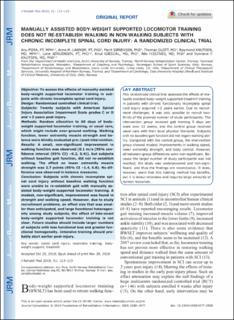| dc.contributor.author | Piira, Anu Mirjam | |
| dc.contributor.author | Lannem, Anne Marie | |
| dc.contributor.author | Sørensen, Marit | |
| dc.contributor.author | Glott, Thomas | |
| dc.contributor.author | Knutsen, Raymond | |
| dc.contributor.author | Jørgensen, Lone | |
| dc.contributor.author | Gjesdal, Knut | |
| dc.contributor.author | Hjeltnes, Nils | |
| dc.contributor.author | Knutsen, Synnøve Fønnebø | |
| dc.date.accessioned | 2020-04-24T09:08:54Z | |
| dc.date.available | 2020-04-24T09:08:54Z | |
| dc.date.created | 2019-06-12T13:52:19Z | |
| dc.date.issued | 2019 | |
| dc.identifier.citation | Journal of Rehabilitation Medicine. 2019, 51(2), 113-119. | en_US |
| dc.identifier.issn | 1650-1977 | |
| dc.identifier.uri | https://hdl.handle.net/11250/2652381 | |
| dc.description | This work is licensed under a Creative Commons Attribution-NonCommercial 4.0 International License. | en_US |
| dc.description.abstract | Objective: To assess the effects of manually assisted body-weight supported locomotor training in subjects with chronic incomplete spinal cord injury. Design: Randomized controlled clinical trial. Subjects: Twenty subjects with American Spinal Injury Association Impairment Scale grades C or D and > 2 years post-injury. Methods: Random allocation to 60 days of body-weight supported locomotor training, or usual care, which might include over-ground walking. Walking function, lower extremity muscle strength and balance were blindly evaluated pre-/post-intervention. Results: A small, non-significant improvement in walking function was observed (0.1 m/s (95% confidence interval (95% CI) –0.2, 0.4)), but subjects without baseline gait function, did not re-establish walking. The effect on lower extremity muscle strength was 2.7 points (95% CI –1.4, 6.8). No difference was observed in balance measures. Conclusion: Subjects with chronic incomplete spinal cord injury without baseline walking function were unable to re-establish gait with manually assisted body-weight supported locomotor training. A modest, non-significant, improvement was found in strength and walking speed. However, due to study recruitment problems, an effect size that was smaller than anticipated, and large functional heterogeneity among study subjects, the effect of late-onset body-weight supported locomotor training is not clear. Future studies should include larger numbers of subjects with less functional loss and greater functional homogeneity. Intensive training should probably start earlier post-injury. | en_US |
| dc.language.iso | eng | en_US |
| dc.subject | spinal cord injury | en_US |
| dc.subject | locomotor training | en_US |
| dc.subject | body-weight support | en_US |
| dc.subject | treadmill | en_US |
| dc.title | Manually assisted body-weight supported locomotor training does not re-establish walking in non-walking subjects with chronic incomplete spinal cord injury: A randomized clinical trial | en_US |
| dc.type | Peer reviewed | en_US |
| dc.type | Journal article | en_US |
| dc.description.version | publishedVersion | en_US |
| dc.rights.holder | © 2019 Foundation of Rehabilitation Information | en_US |
| dc.source.pagenumber | 113-119 | en_US |
| dc.source.volume | 51 | en_US |
| dc.source.journal | Journal of Rehabilitation Medicine | en_US |
| dc.source.issue | 2 | en_US |
| dc.identifier.doi | 10.2340/16501977-2508 | |
| dc.identifier.cristin | 1704366 | |
| dc.description.localcode | Seksjon for coaching og psykologi / Department of Coaching and Psychology | en_US |
| cristin.unitcode | 150,32,0,0 | |
| cristin.unitname | Seksjon for coaching og psykologi | |
| cristin.ispublished | true | |
| cristin.fulltext | original | |
| cristin.qualitycode | 1 | |
